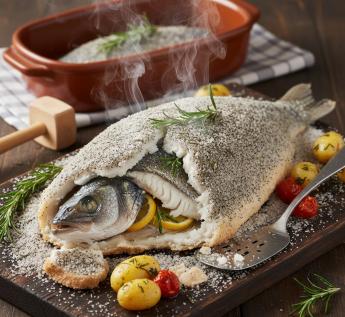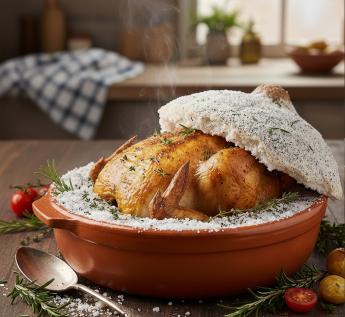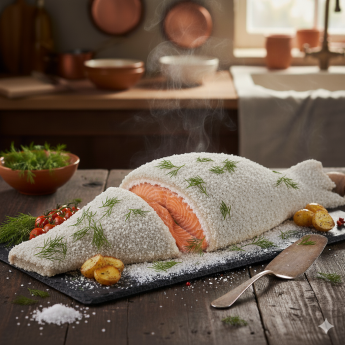Salt Crust
The Secret to Perfect Cooking

Discover or rediscover salt crust cooking with Le Paludier de Guérande coarse gray salt, a simple traditional method that guarantees spectacular results. The magic happens thanks to the formation of a natural, airtight crust. It traps juices and flavors, allowing your whole fish, poultry, or vegetables to cook slowly, without ever drying out.
The main advantage is how incredibly easy it is: simply cover the food with a thick layer of moistened coarse salt. Once cooked, all you have to do is break the crust to reveal incomparably tender and moist flesh, perfectly seasoned by the minerals in the salt, without being too salty.



But beyond its simplicity and culinary qualities, cooking in a salt crust offers a real advantage in terms of originality and aesthetics. Serving a dish in its salt shell is a theatrical gesture that always impresses your guests. The crackling of the crust and the steam that escapes create a complete sensory experience that enhances the quality of your product.
It is the perfect opportunity to highlight the purity and mineral richness of our Le Paludier de Guérande gray salt, an authentic and natural product. It is a healthy cooking method that requires very little or no fat, concentrating the natural flavor of the ingredients. For your next dinner party, opt for a combination of tradition and wow factor with salt crust cooking.
Salt crust recipes

Salt crust cooking is based on the principle of creating an insulating, airtight shell around the food. There are several recipes for “salt dough,” each offering slightly different texture and resistance properties, depending on the type of coarse salt used (such as Gros Sel de Guérande) and the ingredients added.
Here are the main variations in the composition of salt crusts:
1. Simple Salt Crust (Salt + Moisturizer)
This is the purest and quickest method, often preferred for whole fish or vegetables.
Composition: Mainly coarse salt (such as Le Paludier de Guérande) mixed with a liquid binder.
Salt + Egg White(s): This is the most common variation. Egg white, which coagulates when heated, acts as a powerful glue that holds the salt grains together to form a very hard and insulating shell. This crust is clean and easy to break after cooking.
Salt + Water: Simply moistening coarse salt with water forms a malleable mass. Less rigid than the egg white version, it works well for quick cooking and for foods that do not require intense handling before baking.
2. Salt Crust “Salt Dough” (Salt + Flour + Eggs + Water)
This mixture is more like real bread dough, but extremely salty. It produces the most solid crust, ideal for long cooking times (such as poultry or large pieces of meat).
Composition: Coarse salt + flour (often in equal parts with the salt, or slightly less) + whole eggs or egg whites/yolks + water.
Advantages: The flour and eggs create a malleable dough that is easy to roll out and seal tightly. It is very resistant, ensuring a perfect seal for braising and even allowing you to decorate the surface.
Note: Some cooks add olive oil to this dough to improve its texture.
3. Flavored Crust
Regardless of the base chosen (plain salt or salt dough), it is often enriched with herbs to subtly flavor the dish.
Composition: Basic ingredients (salt, flour, eggs) mixed with:
Dried herbs: Thyme, rosemary, oregano, herbes de Provence.
Spices: Crushed pepper, coriander, pink peppercorns.
The use of coarse gray Guérande salt naturally enhances the flavor thanks to its high mineral content and natural moisture, which help to bind the crust together.

